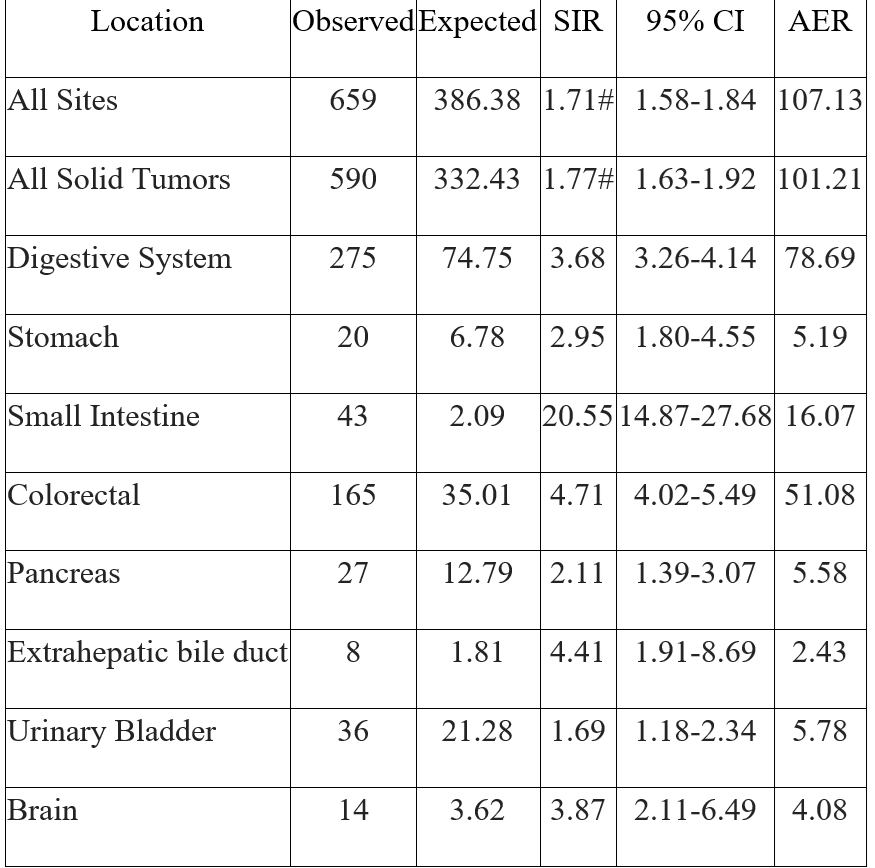Tuesday Poster Session
Category: Small Intestine
P6211 - Second Primary Cancers After Small Bowel Adenocarcinoma: Insights From the Surveillance, Epidemiology, and End Results Database
Tuesday, October 28, 2025
10:30 AM - 4:00 PM PDT
Location: Exhibit Hall

Imran Khan, MD (he/him/his)
NYC Health + Hospitals/Woodhull
Jamaica, NY
Presenting Author(s)
Imran Khan, MD1, Mohammad Ebad Ur Rehman, MBBS2, Aria Khan, MD1, Adil Khan, MBBS3, Pouyan Gohari, MD4
1NYC Health + Hospitals/Woodhull, Jamaica, NY; 2Rawalpindi Medical University, Rawalpindi, Punjab, Pakistan; 3University of Louisville, Louisville, KY; 4NYC Health + Hospitals/Woodhull, Brooklyn, NY
Introduction: Small intestine adenocarcinoma (SBA) is a rare gastrointestinal malignancy often diagnosed at an advanced stage. With improving survival rates, the risk of second primary malignancies (SPMs) in SBA patients has gained clinical importance. In this study, we analyze the incidence of SPMs in patients with SBA to better inform long-term surveillance and survivorship care.
Methods: The Surveillance, Epidemiology, and End Results database (SEER-17) was utilized to undertake a retrospective cohort study. Patients diagnosed with adenocarcinoma (ICD-O-3 8140, 8144, 8210, 8211, 8220, 8221, 8255, 8260, 8261, 8262, 8263, 8480, 8481, 8490, 8574, 8576) on histology and a primary site of small intestine diagnosed between 2000 and 2022 were included. Patients diagnosed at autopsy or lost to follow-up were excluded. SPM was defined as a second tumor diagnosed more than 2 months after the initial SBA diagnosis. Latency was defined as the time between the SBA and the SPM diagnosis. Standardized incidence ratio (SIR) and absolute excess risk (AER) were calculated using SEER*Stat software (version 8.4.0.1). P-values and 95% confidence intervals (95% CI) were generated assuming a Poisson distribution of the observed incidence of SPM.
Results: A total of 7,910 SBA patients were included. SPM was developed in 659 (8.3%) patients. Patients with SBA had a significantly greater risk of developing SPM compared to the general population (SIR 1.71, 95% CI 1.58-1.84). The most common sites of SPM were colorectal (SIR 4.71, 95% CI 4.02-5.49) and small intestine (SIR 20.55, 95% CI 14.87-27.68). Cancers of the stomach (SIR 2.95), pancreas (SIR 2.11), extrahepatic bile duct (SIR 4.41), urinary bladder (SIR 1.69), and brain (SIR 3.87) were significantly more common in patients with SBA compared to the general population. SPM was significantly elevated in patients with latency 2-11 months (SIR 1.30), 12-59 months (SIR 2.04), 60-120 months (SIR 1.36), and more than 120 months (SIR 1.83). Patients aged less than 50 years, 50-75 years, and more than 75 years had a SIR of 6.35, 1.78, and 1.40, respectively. The SIRs for Caucasians, African Americans, and other races (American Indian/AK Native, Asian/Pacific Islander) were 1.62, 1.85, and 2.67, respectively.
Discussion: Patients with SBA are at a significantly increased risk of SPMs, particularly tumors of the digestive tract. SPM risk was elevated across all races, age groups, and latency groups.

Figure: Table A: Risk Estimates of Site-Specific Second Primary Malignancies Among Small Bowel Adenocarcinoma Survivors Using the SEER Database.
Disclosures:
Imran Khan indicated no relevant financial relationships.
Mohammad Ebad Ur Rehman indicated no relevant financial relationships.
Aria Khan indicated no relevant financial relationships.
Adil Khan indicated no relevant financial relationships.
Pouyan Gohari indicated no relevant financial relationships.
Imran Khan, MD1, Mohammad Ebad Ur Rehman, MBBS2, Aria Khan, MD1, Adil Khan, MBBS3, Pouyan Gohari, MD4. P6211 - Second Primary Cancers After Small Bowel Adenocarcinoma: Insights From the Surveillance, Epidemiology, and End Results Database, ACG 2025 Annual Scientific Meeting Abstracts. Phoenix, AZ: American College of Gastroenterology.
1NYC Health + Hospitals/Woodhull, Jamaica, NY; 2Rawalpindi Medical University, Rawalpindi, Punjab, Pakistan; 3University of Louisville, Louisville, KY; 4NYC Health + Hospitals/Woodhull, Brooklyn, NY
Introduction: Small intestine adenocarcinoma (SBA) is a rare gastrointestinal malignancy often diagnosed at an advanced stage. With improving survival rates, the risk of second primary malignancies (SPMs) in SBA patients has gained clinical importance. In this study, we analyze the incidence of SPMs in patients with SBA to better inform long-term surveillance and survivorship care.
Methods: The Surveillance, Epidemiology, and End Results database (SEER-17) was utilized to undertake a retrospective cohort study. Patients diagnosed with adenocarcinoma (ICD-O-3 8140, 8144, 8210, 8211, 8220, 8221, 8255, 8260, 8261, 8262, 8263, 8480, 8481, 8490, 8574, 8576) on histology and a primary site of small intestine diagnosed between 2000 and 2022 were included. Patients diagnosed at autopsy or lost to follow-up were excluded. SPM was defined as a second tumor diagnosed more than 2 months after the initial SBA diagnosis. Latency was defined as the time between the SBA and the SPM diagnosis. Standardized incidence ratio (SIR) and absolute excess risk (AER) were calculated using SEER*Stat software (version 8.4.0.1). P-values and 95% confidence intervals (95% CI) were generated assuming a Poisson distribution of the observed incidence of SPM.
Results: A total of 7,910 SBA patients were included. SPM was developed in 659 (8.3%) patients. Patients with SBA had a significantly greater risk of developing SPM compared to the general population (SIR 1.71, 95% CI 1.58-1.84). The most common sites of SPM were colorectal (SIR 4.71, 95% CI 4.02-5.49) and small intestine (SIR 20.55, 95% CI 14.87-27.68). Cancers of the stomach (SIR 2.95), pancreas (SIR 2.11), extrahepatic bile duct (SIR 4.41), urinary bladder (SIR 1.69), and brain (SIR 3.87) were significantly more common in patients with SBA compared to the general population. SPM was significantly elevated in patients with latency 2-11 months (SIR 1.30), 12-59 months (SIR 2.04), 60-120 months (SIR 1.36), and more than 120 months (SIR 1.83). Patients aged less than 50 years, 50-75 years, and more than 75 years had a SIR of 6.35, 1.78, and 1.40, respectively. The SIRs for Caucasians, African Americans, and other races (American Indian/AK Native, Asian/Pacific Islander) were 1.62, 1.85, and 2.67, respectively.
Discussion: Patients with SBA are at a significantly increased risk of SPMs, particularly tumors of the digestive tract. SPM risk was elevated across all races, age groups, and latency groups.

Figure: Table A: Risk Estimates of Site-Specific Second Primary Malignancies Among Small Bowel Adenocarcinoma Survivors Using the SEER Database.
Disclosures:
Imran Khan indicated no relevant financial relationships.
Mohammad Ebad Ur Rehman indicated no relevant financial relationships.
Aria Khan indicated no relevant financial relationships.
Adil Khan indicated no relevant financial relationships.
Pouyan Gohari indicated no relevant financial relationships.
Imran Khan, MD1, Mohammad Ebad Ur Rehman, MBBS2, Aria Khan, MD1, Adil Khan, MBBS3, Pouyan Gohari, MD4. P6211 - Second Primary Cancers After Small Bowel Adenocarcinoma: Insights From the Surveillance, Epidemiology, and End Results Database, ACG 2025 Annual Scientific Meeting Abstracts. Phoenix, AZ: American College of Gastroenterology.
